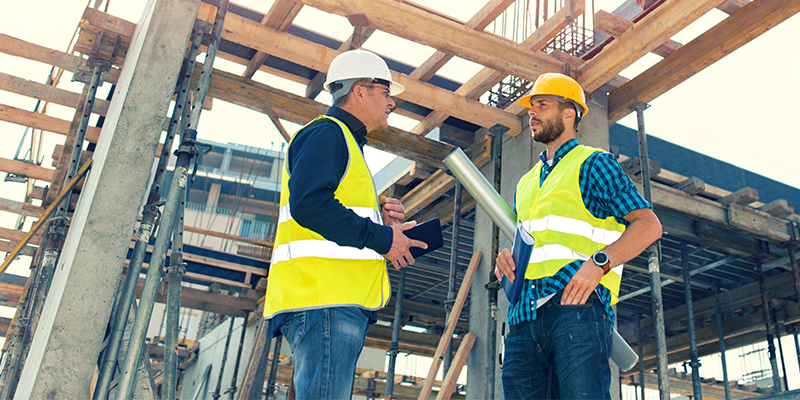In today’s environment, there are countless barriers to new commercial real estate development opportunities, including rapidly rising borrowing rates, increased constraints on banks, growing insurance costs and geopolitical risks, to name a few. On top of that, a major constraint to development today is the rising cost of construction. The upward trajectory of construction spending itself can be attributed to many factors including inflation, labor costs, rising insurance rates, materials and even permitting costs. As the cost to build becomes more expensive, developers are grappling with how to deliver high-quality buildings on time and within budget.
As a result, to achieve deadlines and stay within budget, developers must generate solutions to the industry dilemma of rising construction costs. In this article, we will dive into what’s driving construction spending, how these costs are impacting developers and solutions for maintaining development momentum.
What’s Driving Construction Costs
The cost of building a new project is influenced by a wide variety of external factors but is ultimately governed by fundamental supply/demand dynamics for new construction. Over the last several years, we have seen record new construction deliveries. While the recent rapid rise in the base rate has likely stunted new projects over the last few months, the backlog of projects currently in construction is still 12 to 18 months from completion. While those projects continue, contractors, suppliers and other beneficiaries of the construction cycle may not yet feel the impacts of the coming hiatus in starts, but it is only a matter of time until they do. In the meantime, the market has recently experienced extreme inflation, labor shortages, and materials cost increases – all of which have forced developers to think strategically and focus if they wish to continue to capitalize and complete profitable new projects.
Since 2020, several key construction materials have experienced rapid inflation. Concrete costs nationally have increased by 15%, lumber by 16% and steel by 22%. The escalation in pricing of construction materials has tested developers, and in certain instances forced them to utilize cost-effective alternatives that help projects stay within budget without compromising the quality of construction. Without material price decreases in sight, many developers are utilizing prefabricated structures to help better control costs not only through materials and labor but also through time. Since prefab structures are produced in factories, they are protected from weather delays and benefit from mass production techniques. As such, prefab construction is one of several tools being used by developers.
Another key driver of high construction costs is rising insurance premiums. Currently, in Florida, insurance premiums are the highest in the nation. This is a result of flooding and extreme winds that have led to property damage. Additionally, required tort reform, the current status of the reinsurance market, and the limited (and shrinking) carrier base willing to cover the state are also factors contributing to insurance price hikes. However, insurance is not just a Florida problem. In addition to the issues plaguing Florida, the inflation-driven increases in replacement costs are a national issue causing insurance rates to increase across the country. According to the Wall Street Journal, the costs to insure rental apartment buildings in Dallas rose 14.4% annually on average, 13% in Los Angeles and 12.6% in Houston. These spikes are triggered by rising replacement costs and natural disasters including wildfires, increased rainfall, extreme temperatures and high wind events.
Finally, to add to the myriad of factors outlined above, the limited availability of labor, particularly in the construction workforce, is an acute pain point for developers that has also contributed to setbacks and challenges in construction. The pandemic drove many people to retirement earlier than the historic norm and others to alternative fields. Immigration reform and other cascading factors continue to keep the labor pool low, especially for manual labor-like positions. According to Associated Builders and Contractors, the construction industry needed to attract approximately 546,000 workers to meet the demand for labor in 2023 alone. Furthermore, they reported that the construction industry averaged more than 390,000 job openings per month in 2022, the highest level on record.
These economic influences continue to drive construction costs upwards and are anticipated to continue well into 2024.
How to Thrive Amid Rising Costs
Confronted by rising costs in every facet of the business, real estate developers face both challenges and opportunities. To succeed in this evolving environment, developers must proactively seek innovative solutions that not only mitigate the impact of rising expenses but also add value to their projects.
To start, developers must emphasize efficiency in project management. Streamlining construction processes, optimizing project timelines, and embracing advanced technologies can help reduce construction timelines and minimize labor costs. Leveraging sustainable and energy-efficient designs can not only appeal to environmentally conscious buyers but also lead to long-term savings through reduced operational expenses. Furthermore, collaborating with local municipalities to fast-track permitting and approvals can help expedite projects, reducing carrying costs and improving return on investment.
In addition to enhancing efficiency, developers can explore alternative financing models. Focusing on the right equity and debt in your capital structure is critical to the success of projects in challenging times like today. Compiling the right composition of lower cost, lower leverage financing with higher octane, but more flexible and patient capital is key to a successful project. By embracing creativity and innovation, developers can not only survive the challenges posed by rising construction costs but also thrive in an ever-evolving real estate market.
Ultimately, the challenging market for development today will separate those who survived and those who thrived. Staying disciplined and focused on the best locations and great execution will lead those who persevere to continued success.
Advice for Developers in the Current Environment
While rising construction costs make commercial real estate development more challenging, it is not a new issue. Development costs are cyclical, and the past 24 to 36 months have resulted in one of the more challenging development environments since the global financial crisis. That being said, it is because development is so challenging today that those who persevere find sites that make sense, underwrite and plan appropriately, and are therefore able to capitalize and build to completion.
Development has become trying and many have given up, pivoted to different strategies or sat on the sidelines waiting for things to change. However, those who spend challenging times finding and entitling the best sites, contracting those sites at better terms and pricing, and sitting with shovel-ready projects when construction costs normalize will be well rewarded by outsized rent growth as the only new developments available on the other side of the cycle.
So what should a developer do today? In addition to being the contrarian buyer of sites and benefiting from better pricing and terms, developers must stay laser-focused on execution. Fully vet your budget top to bottom and work with quality general contractors and subs who will stand by what they quote for you. Drive a competitive bidding process, but balance reputation and execution capability with pricing in selection. Understand the minutiae of your cost breakdowns and consider all of the details in the hard and soft costs. Stay sharp on entitlement, permitting, and impact fees, as they can change frequently and differ by specific municipalities. Lastly, include all costs across each phase of development from site selection to land acquisition to pre-development planning, through the ultimate development and construction. If developers abide by these practices, they will thrive in challenging economic conditions.
Closing Thoughts
In conclusion, the commercial real estate development sector is confronting the formidable challenge of escalating construction costs driven by a wide variety of factors. Developers, however, have the power to adapt and thrive in this dynamic environment. By embracing efficiency, innovative construction techniques and alternative financing models, they can not only weather the storm but also add significant value to their projects. Moreover, being a contrarian and focusing on execution fundamentals will reward those who can develop profitably in a challenging environment. Navigating the shifting tides of construction costs with creativity and adaptability will be the key to long-term success, ensuring that developers remain at the forefront of the real estate industry’s evolution and the vanguard of the next cycle.
Content and strategies shared on NAIOP webinars and blog posts are intended to provide information and insights to industry practitioners and do not constitute advice or recommendations. NAIOP and its presenters disclaim any liability for actions taken as a result of these webinars and blog posts.














